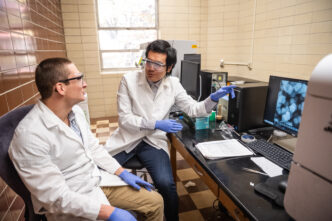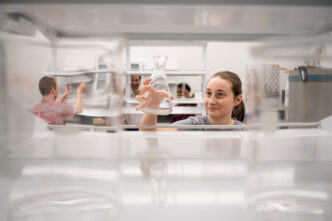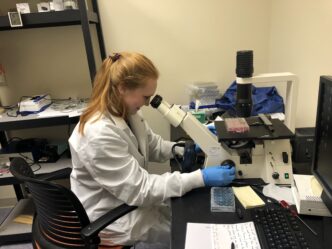Exoskeletons that prevent injuries such as strained backs and shoulders have been available for years but haven’t flooded the workplace as once expected, and a group led by Clemson University industrial engineers would like to know why.
That is the central question behind a new research project that is directed by McQueen Quattlebaum Professor Divya Srinivasan, who joined Clemson in August after six years at Virginia Tech. The research is supported by a $4-million grant from the National Science Foundation.
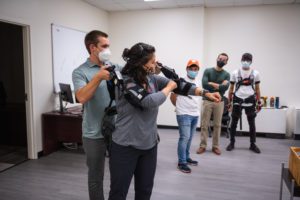
Exoskeletons are wearable devices that help augment or restore users’ natural abilities, making it easier for them to perform physical tasks, such as lifting and moving heavy objects off the ground or above the head.
The Srinivasan research is a step toward shifting exoskeletons out of the realm of sci-fi movies, such as “Iron Man” and “Aliens,” and into people’s daily lives.
Numerous lab-based studies, including some by Srinivasan’s group, have shown that exoskeletons work when subjects perform specific, controlled tasks. Several major companies have also expressed interest in adopting exoskeletons and trying pilot programs.
Yet there are some fundamental research gaps in applying them to real jobs, Srinivasan said.
“Our research is trying to ask, ‘Where is this bottleneck?”” she said. “What’s missing between the laboratory research versus the practical considerations when you get the exoskeletons out there?”
The research could also help people who have difficulty with mobility because of injury or illness.
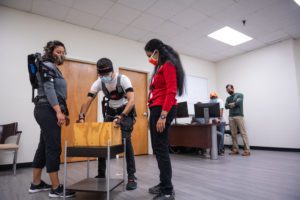
Jessica Avilés, a postdoctoral fellow in Srinivasan’s lab, said she will specialize on exoskeletons for rehabilitation purposes, building on her prior research with lower-limb amputees and older adults.
“There’s a lot of different exoskeleton research in industry and manufacturing, but there is also a big need in rehabilitation,” she said. “Can you improve walking, mobility and quality of life with exoskeletons? I would like to explore that in my NSF-ASEE efellows postdoctoral fellowship program.”
Collaborators on the project include Virginia Tech, the University of South Florida, Brigham Young University, the Florida Institute for Human and Machine Cognition, exoskeleton manufacturers, and representatives from the manufacturing and construction industries.
Srinivasan said the research is unique because the team is not looking at exoskeletons as an isolated piece of technology, but as part of a complex socio-technical system and are considering a wide range of physical, psychological, social and business factors.
“We’re saying we need to evolve and think about this in a systemic way,” Srinivasan said.
It is an approach that appeals to Rahul Narasimhan, who said he learned about Srinivasan’s research after launching an exoskeleton start-up in India. He decided to enroll as a Ph.D. student to learn more about research and development.
“She was trying to figure out how they affect older people and people working in industry and how they can reduce the disorders you get from overworking,” Narasimhan said. “That was a real impact. I wanted that.”
Funding for the research comes through a National Science Foundation program called the Future of Work at the Human-Technology Frontier.
Some of the key barriers to more widespread use of exoskeletons are already known, so the research group has a starting point, Srinivasan said. The barriers include decisions about when to deploy exoskeletons as part of an industrial workflow, understanding the social and organizational culture needed for successful implementation and enabling a faster design-to-device cycle time, she said.
Kevin Taaffe, chair of the Department of Industrial Engineering, said Srinivasan is well suited to lead the project.
“Dr. Srinivasan’s extensive research into exoskeletons and her prior experience in leading major federally funded studies position her and her team for success,” Taaffe said. “I congratulate her on the grant and welcome her to Clemson’s industrial engineering department.”
Srinivasan said Clemson’s reputation in industrial engineering helped convince her to become a Tiger. The department has traditionally had a well-known and reputable program, but the upward trajectory has been particularly pronounced in recent years, she said.
“A whole bunch of young, very promising faculty have been hired,” Srinivasan said. “It’s a good time to be here. There is also an industrial ecosystem in Greenville that is growing and exciting to be a part of for any engineer.”
Srinivasan holds master’s degrees in biomedical engineering and industrial and operations engineering and a Ph.D. in biomedical engineering, all from the University of Michigan.
Anand Gramopadhye, dean of the College of Engineering, Computing and Applied Sciences, said the level of funding for her most recent grant underscores the scholarship that Srinivasan brings to Clemson.
“Dr. Srinivasan and her team are helping shape the future of work with their research,” he said. “I welcome her to the college, she is an exemplar scholar and researcher and I congratulate her on this well-deserved award.”



